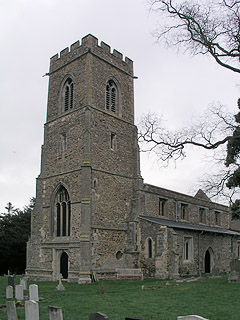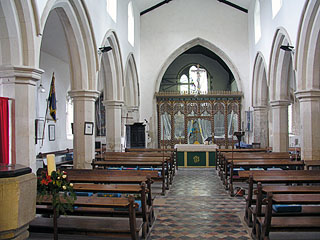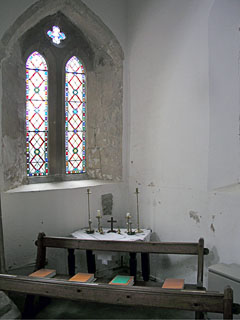If I think about Perpendicular architecture, the examples that spring to mind tend to be the grandest ones: the churches at Burwell or Lavenham in Suffolk, or the chapel of King's College. This might give the impression that it's a style exclusively associated with rich patrons and huge buildings. However, that's entirely wrong - and SS Peter and Paul in Little Gransden is a useful reminder.
Fittingly, it's a very small church - and from the outside one might agree with Pevsner that it looks like it was completely rebuilt by the Victorians. The weathering on the stone suggests otherwise, though. This is the carstone belt of the county, where the Lower Greensand reaches the surface, and Little Gransden - like Gamlingay and Longstowe nearby - is built of the glorious treacle-coloured rock that crops up all along a thin line running from Hunstanton down and along the northern edge of the Chilterns. It's a pretty stone, used to good effect here It does tend to weather very quickly however.
The west tower is very thin, which makes it look tall. The carstone is supplemented by harder stone, and this is surprisingly well-decorated - there is a solid base course, and the diagonal buttresses have elaborate little gables as they rise at each stage.
The doorway is a typical square-framed affair, and the west window above it fills most of the west face. Above it, just below the bell-stage, is another line of harder stone decorated with criss-crossed carving. It's all rather good.
The rest of the exterior is rather over-restored, but some of the square-headed windows look original, and the Victorians were very careful to copy them faithfully.
When we visited, the church was locked with no information about keyholders. There was, however, a telephone number for the vicar, and so we gave her a call. She passed us onto someone who holds the key. Both seemed so friendly that I suspect the church is usually kept open. When we visited, though, the chancel was being restored. This was a trifle inconvenient since we had to enter through the priest's door and pick our way through the scaffolding and plastic sheeting. As we headed for the nave, I did notice a reasonably nice piscina at the east end, but other than that there was little to get excited about. For the most part, the chancel was restored in the 1870s, and the new roof and windows aren't particularly nice.
Approaching from the east did mean, though, that we didn't see the screen until we were right upon it. It dates from the 15th century, and is quite lovely: the tracery is very delicate, and the uprights are decorated with engaged shafts leading up to little pedestals. The central arch is wider than the side ones, and decorated with bosses depicting animals - the other openings (there are two lights on each side) are decorated with pomegranates.
The chancel arch is very small, and this is a very little screen - 'human-sized', as Mark said. Like its church, it was extensively restored by the Victorians. To them we owe the remarkable colour scheme: the main structure is painted in familiar shades of red, green and gold, but the engaged shafts at the front are done out in vivid black and white barber's pole stripes. The Victorians also gave it a little Rood above the central arch, and put very fine angels with outstretched wings on top of the pedestals at the front, complete with shields depicting the symbols of the passion. [Mark adds: the mini-rood was covered up in a plastic bag, as you can see in the picture - no doubt to protect it during the work - this looked terribly liturgical to me, so much so that I had to check the date in case we were in that part of lent when crucifixes are supposed to be covered.]
The rest of the church is pleasant, though there's little enough to mention. The nave arcades are 13th century, but (one small lancet in the south aisle aside) the rest is all Perpendicular. As one would expect from the exterior, the tower arch was unusually tall and narrow - the effect is rather spoiled, though, by the horrible orange glass in the west window, which filled the west end of the church with a rather lurid glow. Still, that's only a minor annoyance.
SS Peter and Paul was locked without a keyholder listed when we visited -
I don't know how normal this is.



